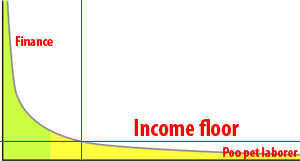Some thoughts after reading a copy sent to me by superhero Whitney Hoffman. The Dip is an interesting book, but a lot of the ways it’s been marketed don’t really work with the subject matter, at least not for me. It’s marketed… well, poorly. Every review, every interview I’d heard prior to receiving the book had convinced me this was one to definitely skip, and buy something else instead.
Had the marketing said, “In addition to all the feel good motivational stuff, you’ll also learn how the Dip relates to the Long Tail, and which strategy makes sense for you” I think I would have been in line the day the book went on the market.
The Long Tail, if you haven’t read it, by Chris Anderson, is a book about power law curves. We know them primarily through cliches – 80% of your business comes from 20% of your customers, 1% of the world’s population has 99% of the wealth, etc. The Long Tail proposes different thinking in a digital marketplace – in a realm where you have infinite shelf space, you can offer infinite products and do very well – better, in fact, than a brick and mortar shop that can only serve the short head. The Long Tail is about the power of aggregation.
The Dip is about the short head. It’s about the top of the powerlaw curve, because being #1, even if the tail is really long, is more profitable as an individual because you cannot aggregate some things. Can you be #34 – #447 in your job? Not really, unless you can clone yourself. The Dip is about scarcity, while the Long Tail is about abundance. Be #1, because #2 experiences drastically fewer benefits than #1, and #3 – #infinity are pretty much screwed.
The Dip is also a strategic warfare book. The phenomenon known as the Dip, the barrier between top performer and dabbler, between #1 and everything else, is a filter – it’s the barrier that ensures that whoever is #1 in any given niche is there for a reason. Because we’re talking an economoy of scarcity, it’s also zero sum – if you are #1, no one else can be, and vice versa. In the book are a number of tips which will allow you to make the Dip a deadly quagmire for your opponents and competitors – ways to distract them, divert them, so that while they’re tilting at windmills, you’re going to the bank. I’d recommend combining the strategic aspects of the Dip with a more warfare-oriented book like the Art of War for best results.
Finally, the Dip and the Long Tail plug into each other. Take the Long Tail of careers, for example, and figure out which careers pay the income you want to earn (red line on graph 1). Even the best, top of the food chain career in some fields will still not pay out like it will in other fields; for example, you may be the best poo pet crafter in the world, but if the #1 position in poo pet manufacturing doesn’t fall above the baseline income you want to make, then that’s not the niche for you. Ideally, pick a career or field in which there’s a decent amount of cushion between what you want to earn and what the #1 person in that niche earns.

Then, if you’re #2 or #3, you’re still making what you want to make while clawing your way to the top. That little slice of the short head is where you want to live.

Overall, I’d recommend The Dip. It’s a good read with marketing that didn’t touch me at all.
Leave a Reply